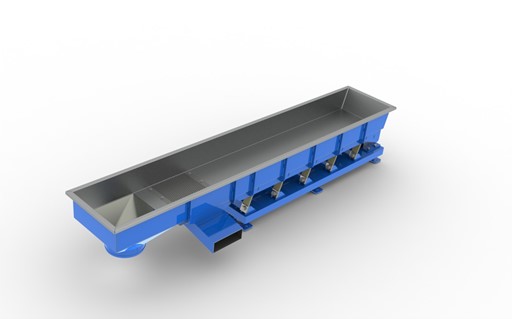5 Things You Should Be Looking Out for When Selecting a Linear Vibratory Feeder
Home / 5 Things You Should Be Looking Out for When Selecting a Linear Vibratory Feeder

5 Things You Should Be Looking Out for When Selecting a Linear Vibratory Feeder

There are several factors to consider when selecting a linear vibratory feeder for your production line. It's essential to choose a model that can spread an even load of bulk product onwards to the next processing machinery with a clearly defined feed rate.
You'll also need to consider the size and shape of the parts you're feeding and even the ambient conditions in your plant. In this article, we look at the five most important factors to consider when specifying a vibratory feeder.
1) How The Material Is Being Presented on The Feed Entry Point
There are three primary methods in which material is placed on the entry point of a vibratory feeder:
- Continuous Feed – when the materials are fed constantly onto the feeder’s entry point, usually through an previous automated process and can be delivered by conveyor or screw feeders for example.
- Batch Feed – when the product material is handling in discrete batches of a certain weight or volume as opposed to a continual feed
- Hopper Feed – this method discharges product from a temporary holding hopper onto the vibratory feeder normally situated directly above the hopper. It's often used for dry chemicals, pharmaceuticals, plastics and foodstuffs.
- Manual Feed – this method allows the emptying of bagged product, for example 25 kg bags, or the emptying of sacks or trays of product directly onto the feeder.
2) Drive Design
Linear vibratory feeders can be designed using motor drives or electro-magnetic drives - both designs suitable for different applications. The material is fed onto the feed entry point by one of the three means mentioned above, then carried forward on the feeder tray allowing a smooth and consistent delivery of product to the tray edge at a specific speed that's calculated by taking into account the type and volume of material being fed as well as the dimensions of the feeder tray. Both systems provide a long-life service, robust and easy to clean.
3) Tray / Feeder Dimensions
The tray dimension of the vibratory feeder, in particular its width and depth, should be considered carefully to accommodate the type and volume of product to be fed. For example, a start/stop feeder with a narrow and shallow tray would suit small batches of granular type material with an E-Mag drive. If your plant requires parts feeding at continual high speeds with throughputs of tonnes per hour, then a linear feeder utilising twin out-of-balance motors would be more suitable.
4) General Construction
The feeder inlets and outlets must be taken into account and can be designed to any shape or size to accommodate pre and post production line equipment specifications with many options including enclosing covers and in some applications to remove fine dust particles using a small screening plate, can be incorporated. Mild steel painted or stainless steel frames with stainless-steel trays can be supplied depending on your application and equipment regulations.
5) Feeding The Next Process
Depending on your specific requirements, you may need to consider how your product needs to be delivered to the next process. Gough can provide the right advice if you need straight edges, scarfed-edges for perpendicular conveyors or reduced tray neck for bin or multi-head weighers, for instance. The design and dimensions of these elements will allow for excellent product flow integration with your linear vibratory feeder to avoid any bottlenecks.
What Next?
Gough Engineering offers a wide range of product handling solutions for various applications, including bucket elevators and vibratory feeding equipment. To discuss your application or to find out more, please call 01782 567770 today.
Other Articles
- From rubbish to recycled
- Circular separators versus linear separators
- The power of gentle handling with bucket elevators
- Meeting the surge in demand for grain-based foods
- Overcoming rising energy prices
Contact Gough
Contact our team of highly skilled engineers to discuss your custom requirements today. .
Enquire TodayOther areas you may be interested in…
Have An Enquiry
Call our team of highly skilled engineers to discuss your requirements on 01782 493127 or fill out our online enquiry form.
Enquire Today

